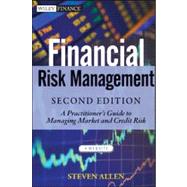
Note: Supplemental materials are not guaranteed with Rental or Used book purchases.
Purchase Benefits
What is included with this book?
STEVEN ALLEN is a risk management consultant, specializing in risk measurement and valuation with a particular emphasis on illiquid and hard-to-value assets. Until his retirement in 2004, he was Managing Director in charge of risk methodology at JPMorgan Chase, where he was responsible for model validation, risk capital allocation, and the development of new measures of valuation, reserves, and risk for both market and credit risk. Previously, he was in charge of market risk for derivative products at Chase. He has been a key architect of Chase's value-at-risk and stress testing systems. Prior to his work in risk management, Allen was the head of analysis and model building for all Chase trading activities for over ten years. Since 1998, Allen has been associated with the Mathematics in Finance Master's Program at New York University's Courant Institute of Mathematical Sciences. In this program, he has served as Clinical Associate Professor and Deputy Director and has created and taught courses in risk management, derivatives mathematics, and interest rate and credit models. He was a member of the board of directors of the International Association of Financial Engineers and continues to serve as co-chair of their Education Committee.
Foreword
Preface
Acknowledgments
Chapter 1: Introduction
1.1 Lessons from a Crisis
1.2 Financial Risk and Actuarial Risk
1.3 Simulation and Subjective Judgment
Chapter 2: Institutional Background
2.1 Moral Hazard???Insiders and Outsiders
2.2 Ponzi Schemes
2.3 Adverse Selection
2.4 The Winner?s Curse
2.5 Market Making versus Position Taking
Chapter 3: Operational Risk
3.1 Operations Risk
3.2 Legal Risk
3.3 Reputational Risk
3.4 Accounting Risk
3.5 Funding Liquidity Risk
3.6 Enterprise Risk
3.7 The Identification of Risks
3.8 Operational Risk Capital
Chapter 4: Financial Disasters
4.1 Disasters Due to Misleading Reporting
4.2 Disasters Due to Large Market Moves
4.3 Disasters Due to the Conduct of Customer Business
Chapter 5: The Systemic Disaster of 2007-2008
5.1 Overview
5.2 The Crisis in CDOs of Subprime Mortgages
5.3 The Spread of the Crisis
5.4 Lessons from the Crisis for Risk Managers
5.5 Lessons from the Crisis for Regulators
5.6 Broader Lessons from the Crisis
Chapter 6: Managing Financial Risk
6.1 Risk Measurement
6.2 Risk Control
Chapter 7: VaR and Stress Testing
7.1 VaR Methodology
7.2 Stress Testing
7.3 Uses of Overall Measures of Firm Position Risk
Chapter 8: Model Risk
8.1 How Important is Model Risk?
8.2 Model Risk Evaluation and Control
8.3 Liquid Instruments
8.4 Illiquid Instruments
8.5 Trading Models
Chapter 9: Managing Spot Risk
9.1 Overview
9.2 Foreign Exchange Spot Risk
9.3 Equity Spot Risk
9.4 Physical Commodities Spot Risk
Chapter 10: Managing Forward Risk
10.1 Instruments
10.2 Mathematical Models of Forward Risks
10.3 Factors Impacting Borrowing Costs
10.4 Risk-Management Reporting and Limits for Forward Risk
Chapter 11: Managing Vanilla Options Risk
11.1 Overview of Options Risk Management
11.2 The Path Dependence of Dynamic Hedging
11.3 A Simulation of Dynamic Hedging
11.4 Risk Reporting and Limits
11.5 Delta Hedging
11.6 Building a Volatility Surface
11.7 Summary
Chapter 12: Managing Exotic Options Risk
12.1 Single-Payout Options
12.2 Time-Dependent Options
12.3 Path-Dependent Options
12.4 Correlation-Dependent Options
12.5 Correlation-Dependent Interest Rate Options
Chapter 13: Credit Risk
13.1 Short-Term Exposure to Changes in Market Prices
13.2 Modeling Single-name Credit Risk
13.3 Portfolio Credit Risk
Chapter 14: Counterparty Credit Risk
14.1 Overview
14.2 Exchange-traded Derivatives
14.3 Over-the-counter Derivatives
Bibliography
About the Companion Website
IndexThe New copy of this book will include any supplemental materials advertised. Please check the title of the book to determine if it should include any access cards, study guides, lab manuals, CDs, etc.
The Used, Rental and eBook copies of this book are not guaranteed to include any supplemental materials. Typically, only the book itself is included. This is true even if the title states it includes any access cards, study guides, lab manuals, CDs, etc.